AnyRoR 7/12 Gujarat 2024 – Search Urban, Rural Land Records Online
AnyRoR (Any Records of Rights) is an essential online platform developed by the Gujarat government to facilitate easy access to land records. Whether you’re looking to verify ownership, track historical changes, or simply gather information on a particular plot, AnyRoR provides an efficient and user-friendly way to obtain both urban and rural land records in Gujarat. This service is a crucial tool for landowners, buyers, and legal professionals, ensuring transparency and accuracy in land-related transactions.
Land Records Available on AnyRoR Portal
The AnyRoR portal offers a wide array of land records to cater to different needs. From urban property details to rural land ownership records, the platform serves as a comprehensive database for Gujarat’s land-related information on wbsedcl.net.

The key records available on this portal include the 7/12 Utara, 8A Khata details, and VF 6 Entry details, among others. These records play a vital role in verifying land ownership, understanding land usage, and accessing historical data that may impact land value or usability.

| Digitally Signed RoR Request Process | Urban Land Records |
| Rural Land Records | E-Milkat Online Property Card |
What is AnyRoR?
AnyRoR stands for “Any Records of Rights” and is a digital initiative by the Gujarat government to centralize land records and make them easily accessible to the public. The platform is designed to replace traditional methods of record-keeping, which were often tedious and prone to errors.
By digitizing these records, AnyRoR ensures that all land-related information is accurate, up-to-date, and available at the click of a button. This initiative is part of a broader move towards e-governance, aiming to enhance transparency and reduce corruption in land dealings.
How do Land Records Help Us?
Land records are not just about ownership; they are critical tools for various legal and administrative processes. These records help in verifying property titles, which is essential during the sale or purchase of land. They also assist in resolving disputes by providing historical data on land ownership and transfers.
Moreover, these records are used by banks when sanctioning loans against property and by government agencies for planning and development purposes. Therefore, access to accurate land records via AnyRoR is invaluable for both individuals and institutions.
Types of Land Records
The AnyRoR portal provides access to multiple types of land records, each serving a specific purpose:
- 7/12 Utara: This is the most commonly accessed document, providing details on land ownership, cultivation, and type of crops grown.
- 8A Khata Details: This document records the ownership and changes in ownership of a particular plot.
- VF 6 Entry Details: These are records of land mutations, documenting any changes in ownership or rights due to sales, inheritance, or other legal actions.
These documents collectively ensure that all aspects of land ownership and usage are well-documented and easily accessible.
How to Check 7/12 or AnyRoR Gujarat Land Records?
To access the 7/12 Utara and other land records online in Gujarat, you first need to visit the official AnyROR portal, which is accessible at www.anyror.gujarat.gov.in. This portal, known as AnyROR @ Anywhere Gujarat, provides a convenient way for citizens to obtain important land records such as the 7/12 Utara, 8A Khata, and other related documents without needing to visit government offices in person.
Types of AnyROR Rural Land Records
The AnyROR portal provides a variety of land records specific to rural areas in Gujarat. These records are essential for verifying ownership, understanding land usage, and accessing historical data related to land transactions. Below is a list of the different types of rural land records available on the portal:
- Old Scanned VF-6 Entry Details: Historical records showing entry details, crucial for tracking past land ownership and transactions.
- Old Scanned VF-7/12 Details: Older scanned versions of the 7/12 Utara, a document that outlines land ownership, type of cultivation, and crop information.
- VF-6 Entry Details: The most up-to-date record of entries for land, documenting ownership and any recent changes.
- VF-7 Survey Number Details: Provides detailed information about the land under a specific survey number, including ownership and land use.
- VF-8A Khata Details: This document records ownership and transactions related to a specific plot of land.
- 135- Notice for Mutation: Notices related to changes in ownership or rights over a piece of land, often following a sale or inheritance.
- Entry List by Month-Year: A historical listing of land records based on the month and year, useful for tracking changes over time.
- New Survey No from Old for Promulgated Village: This record helps you track the new survey number corresponding to the old one after village reorganization or resurvey.
- Integrated Survey No Details: Consolidated information about a specific survey number, combining various records for comprehensive data.
- Revenue Case Details: Information about legal cases related to the land, including disputes over ownership or land use.
- Know Khata by Owner’s Name: Allows you to search for land records by the owner’s name, simplifying the process of locating specific properties.
Tip: You can select any of these land records depending on your needs. The AnyROR website will prompt you for different details based on the land record type you select.
View Land Record – Rural
Go to Homepage > View Land Record – Rural
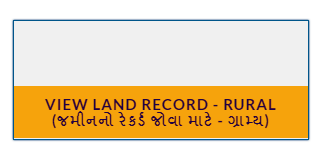
Step 1 – Enter Rural Land Details
To begin viewing your rural land record, follow these steps:
- Select the Land Record Type: Start by choosing the specific type of land record you need from the list mentioned above.
- Enter Location Details: You will then need to enter details about the location of the land. This includes the District, Taluka, Village, and Survey/Block Number where your land is situated.
- Captcha Verification: After entering all the necessary information, solve the captcha to verify your request.
- Get Record Detail: Click on the “Get Record Detail” button to retrieve your land records.

Step 2 – View Rural Land Record Details
Once you’ve completed the steps above:
- View the Details: The land record details will appear on your screen. The specifics you see will vary depending on the type of record you selected.
- Review Ownership and Land Details: For instance, if you selected VF-7, you’ll be able to review information like Ownership Details, Land Details, Boja (encumbrances), and Other Rights related to the land.
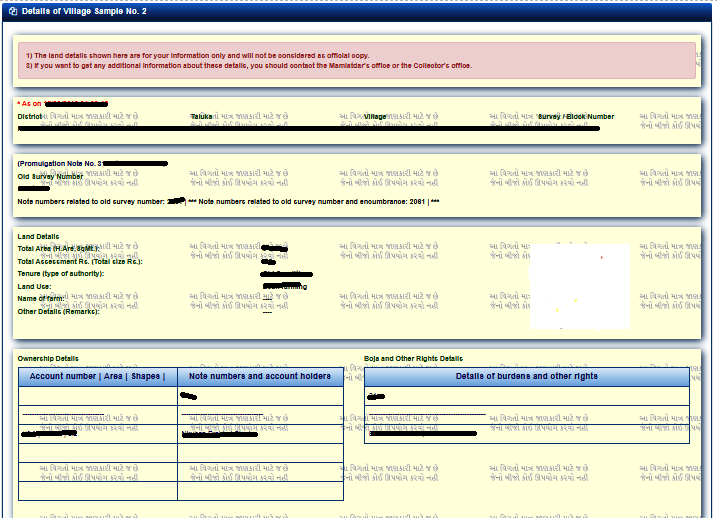
Each land record type will provide different sets of information, tailored to meet the specific needs of the user. Whether you need historical data, current ownership details, or information on legal disputes, the AnyROR portal makes it easy to access the information you need.
Types of AnyROR Urban Land Records
The AnyROR portal offers a range of land records specific to urban areas in Gujarat, which are essential for verifying property details, ownership, and legal standings. Below are the different types of urban land records you can access on the portal:
- Survey No. Details: Provides detailed information about the property under a specific survey number, including ownership and land use.
- Nondh No. Details: This record includes important details related to property registrations and transactions, often referred to as “Nondh” in local terms.
- 135D – Notice Details: This notice relates to any changes or updates in property ownership or rights, typically following a sale, inheritance, or other legal actions.
- Know Survey No by Owner Name: This feature allows users to find the survey number of a property by searching with the owner’s name, making it easier to locate specific records.
- Entry List by Month-Year: A historical listing of property records based on the month and year, useful for tracking ownership and other changes over time.
View Land Record – Urban
Go to Homepage > View Land Record – Urban
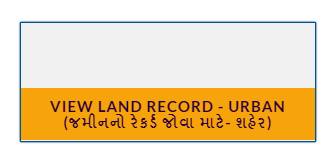
Step 1 – Enter Urban Land Details
To view urban land records, follow these steps:
- Select Property Card Type: Begin by choosing between the two available options: Property Card or Unit Property Card. These options will guide you to the specific type of land record you need.
- Choose the Land Record Type: After selecting the property card type, pick the specific land record type from the list mentioned above.
- Enter Location Details: You will then need to provide details such as the District, City Survey Office, Ward, or Sheet Number where your property is located.
- Additional Details: Depending on the land record type you selected, the portal may ask for additional information to refine the search.
- Captcha Verification: After filling in all the required details, solve the captcha to verify your request.
- Get Record Detail: Click on the “Get Record Detail” button to retrieve the urban land records.
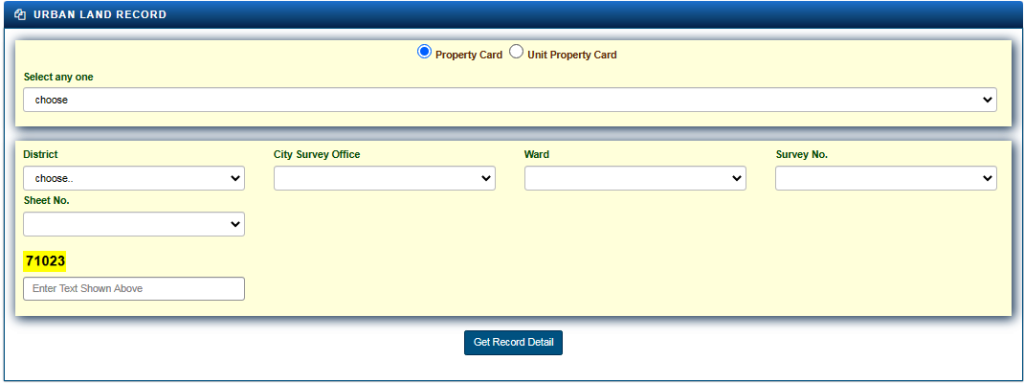
Step 2 – View Urban Land Record Details (Property Card)
Once you have completed the steps above:
- View the Property Card Details: The details of the property card will be displayed on your screen. This document provides a comprehensive overview of the property and is crucial for any property-related transactions or legal matters.
- Verify Property Information: The property card includes several important details:
- Land Details: Information about the land size, boundaries, and other specifics.
- Use of Property: Details on how the property is currently being utilized, whether for residential, commercial, or other purposes.
- Original Holder and Existing Holder: Information on the original and current owners of the property.
- Property Tax Details: Records of property tax assessments and payments.
- Sub-Registrar Deed Details: Legal documents related to the registration of the property.
- IRCMS Revenue Case Details: Information on any revenue cases associated with the property.
- High Court/Civil Court Details: Legal proceedings related to the property, if any.
- Jantri Details: The government-set valuation of the property, often used for taxation and legal purposes.
By reviewing these details, you can verify the accuracy of the property records, which is crucial before finalizing any property transactions or using the information for legal or administrative purposes.
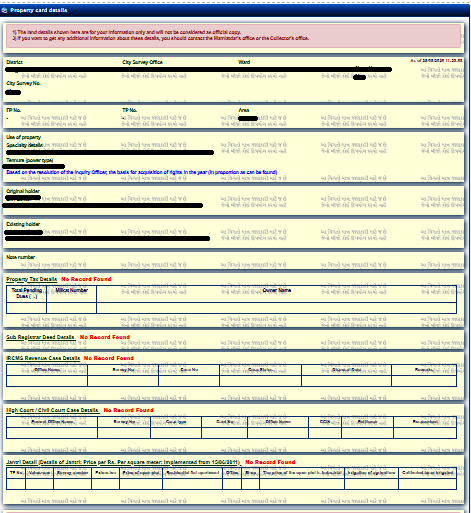
Property Search
Go to Homepage > Property Search

Step 1 – Select Search Method and Enter Land/Property Details
When searching for your property on the AnyROR portal, you have three different methods to choose from, depending on the information you have about the property:
- Property Wise: This method allows you to search for property records based on specific property details such as the survey number or property card number.
- Name Wise: If you know the name of the property owner, you can search for the property records using this information. This is particularly useful if you don’t have specific property details but know the owner’s name.
- Document No-Year Wise: This method allows you to search based on the document number and the year of registration, which is ideal if you have the registration details of the property.
After selecting the most appropriate method:
- Enter Location Details: You will need to select the District, Sub-Registrar Office, and Village where the property is located.
- Provide Verification Details: Next, enter your Applicant Name (Your Name), Mobile Number, and E-mail ID for verification purposes. An OTP (One-Time Password) will be sent to your mobile number.
- Verify with OTP: After receiving the OTP, enter it into the portal and click on the “Get Record Detail” button to proceed.

Step 2 – View Land/Property Details
Once the above steps are completed, the details of the property will appear on your screen. This information typically includes:
- Ownership Details: Information about the current and previous owners of the property.
- Land Details: Details about the land, including size, boundaries, and any specific characteristics.
- Other Property Details: Additional information such as encumbrances, property tax records, and legal case details.
You can use this information to verify the ownership and legal status of the property. These details are essential when preparing to sell the property, as they serve as evidence of ownership and can help ensure a smooth transaction.
This process is designed to be straightforward and user-friendly, allowing you to access critical land and property records quickly and efficiently.
Types of Digitally Signed RoR (Record of Rights)
The AnyROR portal provides access to various types of land records that can be digitally signed, ensuring their authenticity and legal validity. Below are the different types of digitally signed RoR available:
- જુના ગામ નમૂના નં. 6 (Old Village Form No. 6): Historical records of land transactions and ownership details, useful for tracing the history of land ownership.
- ગામ નમૂના નં. 7 (Village Form No. 7): This form contains details about the land’s survey number, ownership, and the current status of the land.
- ગામ નમૂના નં. 12 (Village Form No. 12): This document records the crop details for a specific survey number, showing what crops were planted and harvested.
- ગામ નમૂના નં. 8 એ (Village Form No. 8A): This form is used to track the Khata (account) details of landowners, showing the land holdings under each account.
- ગામ નમૂના નં. 6 (Village Form No. 6): This form provides detailed information on land transactions and changes in ownership over time.
Digitally Signed RoR
Go to Homepage > Digitally Signed RoR

To access and download a digitally signed Record of Rights (RoR), follow these steps:

Step 1 – Select Record and Location
- Choose the Required Land Record: Begin by selecting the specific type of RoR you need from the options listed above.
- Enter Location Details: Select the district, taluka, and village where your land is located.
- Add Village Form: After selecting the location, click on the “Add Village Form” button to proceed.
- Preview the Selected Record: Before proceeding, you can preview the land record to ensure that all details are correct.
- Proceed for Payment: Once everything is confirmed, click the “Proceed for Payment” button to move forward with the process.

Step 2 – Download Digitally Signed RoR
- Make the Required Payment: Complete the payment process as per the portal’s instructions.
- Download the RoR: After payment, you can download your digitally signed RoR. This document is legally valid and can be used for any official purposes, such as property transactions or legal disputes.

By obtaining a digitally signed RoR, you ensure that your land records are up-to-date, authentic, and recognized for all official purposes. This digital signature provides a secure and legally binding record of your land ownership and other related details.
How to Check 7/12 Online – AnyROR Gujarat Portal?
To check your 7/12 land record in Gujarat, visit the official website of AnyROR at anyror.gujarat.gov.in. This portal allows you to access various land records online, including the 7/12 farmer certificate, old 7/12 Utara, and other essential land documents.
Important Notes:
- Informational Purpose Only: The online land records available on the AnyROR portal are primarily for informational purposes. They allow you to view and verify land details conveniently.
- Digitally Signed RoR: If you need to use these records for any official work, ensure you download a Digitally Signed RoR (Record of Rights). This digitally signed document is legally valid and can be used in official transactions, legal disputes, or any other formal processes.
- Physical Copy Requirement: In cases where a digitally signed RoR is not available for your specific location, you will need to obtain a physical copy of the land record. This physical copy can be collected from the Revenue Department (Tahsil Office) in your area. The physical document will be required for any official use if the digital version is unavailable.
By using the AnyROR portal, you can efficiently access and verify your land records, ensuring that all information is accurate and up-to-date before you proceed with any property-related transactions.
Important Links
To ensure users can easily access the information they need, the AnyRoR portal provides several important links. These include direct links to view rural and urban land records, property search, and other related services. These links are essential for navigating the portal efficiently and finding the required documents quickly.
| Visit AnyRoR Portal |
| –> anyror.gujarat.gov.in |